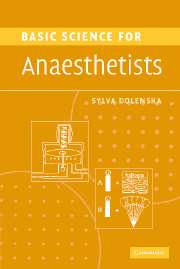Book contents
- Frontmatter
- Contents
- List of abbreviations and symbols
- List of figure captions
- Forewords
- Preface
- Preface to the second edition
- Part 1 Physics, mathematics, statistics, anaesthetic apparatus
- Part 2 Clinical measurement
- 1 Basic measurement concepts
- 2 Electromanometers, frequency response and damping
- 3 Pulse oximeter principle
- 4 Oxygen content and oxygen tension measurement
- 5 Capnography
- 6 [H+], pH and its measurement
- 7 Principles of measurement of volume and flow in gases and liquids
- 8 Cardiac output measurement by thermal dilution technique
- 9 Measurement of the mechanical properties of the chest
- 10 Lung volumes and their measurement
- Part 3a Physiology: the cardiovascular system
- Part 3b Physiology: the respiratory system
- Part 4 Pharmacology
- Further Reading
- Index
4 - Oxygen content and oxygen tension measurement
from Part 2 - Clinical measurement
Published online by Cambridge University Press: 13 August 2009
- Frontmatter
- Contents
- List of abbreviations and symbols
- List of figure captions
- Forewords
- Preface
- Preface to the second edition
- Part 1 Physics, mathematics, statistics, anaesthetic apparatus
- Part 2 Clinical measurement
- 1 Basic measurement concepts
- 2 Electromanometers, frequency response and damping
- 3 Pulse oximeter principle
- 4 Oxygen content and oxygen tension measurement
- 5 Capnography
- 6 [H+], pH and its measurement
- 7 Principles of measurement of volume and flow in gases and liquids
- 8 Cardiac output measurement by thermal dilution technique
- 9 Measurement of the mechanical properties of the chest
- 10 Lung volumes and their measurement
- Part 3a Physiology: the cardiovascular system
- Part 3b Physiology: the respiratory system
- Part 4 Pharmacology
- Further Reading
- Index
Summary
Definitions
Oxygen content: oxygen bound by haemoglobin + oxygen dissolved in solution. Measured as volume at STP or molecular mass (the relationship between volume at STP and mass is constant, see Avogadro's law).
The amount of oxygen bound by haemoglobin depends on haemoglobin concentration, its oxygen-carrying capacity and oxygen saturation. The first and last factors are variable. Oxygen carrying capacity is fairly constant.
Oxygen tension: partial pressure of oxygen in solution (pO2). Measured in units of pressure (mmHg or kPa).
Oxygen concentration: strictly speaking applies only to concentration in a gaseous mixture (e.g. air has 21% oxygen). Sometimes applied to oxygen content.
Oxygen saturation: oxygen content/oxygen carrying capacity. See pulse oximetry and oxygen dissociation curve.
Oxygen content measurement
Physical method: van Slyke (Figure 65)
This is a manometric method. Instead of volume the apparatus measures pressure at constant volume and temperature. Change in pressure then accurately reflects change in the mass of gas (Avogadro's and Boyle's laws apply).
Oxygen has to be released from the blood sample by haemolysing the red cells with saponin and treating haemoglobin with ferricyanide to convert it to methaemoglobin – this releases all oxygen bound to haemoglobin. At the same time, CO2 is released by the application of lactic acid. The released gases are extracted into vacuum and compressed to a standard volume. Vacuum extraction and subsequent compression is done by the means of lowering and raising the mercury levelling bulb.
- Type
- Chapter
- Information
- Basic Science for Anaesthetists , pp. 80 - 85Publisher: Cambridge University PressPrint publication year: 2006



